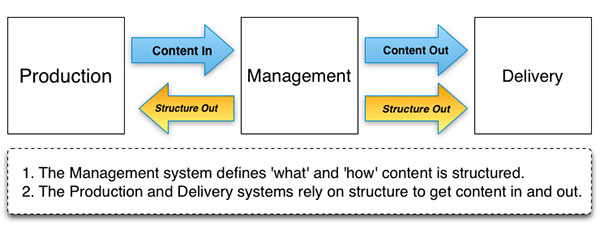One of my clients is about to go-live with the first phase of their content management programme this Summer. It’s not called that of course, it never is, but that’s what it really is. I’m made up for them. And after three hard years defining, crafting, and defending their business case, it took only one year to deliver.
My client is a media publisher; content is their business. They engaged us just over two years ago to help nudge their business case over the line and implement the content managed solution. What was supposed to take a couple of weeks ticking contractual boxes and reviewing requirements, ended up taking twelve months of real hard work trying to answer a very simple question:
- What is content management to you and how do we do it effectively?
Time to ACT.
Here’s the thing, we needed to consider Audience, Content and Technology in that order, to ACT. I can’t remember where I first heard this term, but I believe is was something to do with Deane Barker. In our case:
- Audience. Our customers were mobile, digital savvy, and everywhere; yet we were not reaching them.
- Content. Our content was great and growing; yet we couldn’t get content everywhere it needed to be fast enough.
- Technology. Our home grown content management system (CMS) was mission critical; yet we knew it was no longer fit for purpose.
So we went basic to basics, embraced ACT, and focussed on content management. We dropped the word ‘system’ from CMS. We also refrained from replacing ‘system’ with ‘strategy’ because we needed to understand and define what management means to the business, before planning to do it effectively. So, all our attention was on management.
We then embarked on a journey of discovery. It wasn’t positioned as that at the time, more like a series of experiments (kaizens) that we ran one by one, to learn by doing. Easier done than said. We looked at the strengths and weaknesses across the business, then very quickly separated content management into three distinct areas; production, management and delivery. We also pulled together our collective experience gained working in the content business and concluded:
- As a publisher, we knew how to produce great content, but were ill equipped for multi-channel delivery.
- As an business, we were digitally immature but were getting more experience producing (structured authoring) and delivering (responsive design) content.
- Across the board, we were struggling with content management that was negatively impacting both production and delivery.
Production and delivery systems rely upon a clear content management vision that defines how content is structured and accessed. With a clear vision, production gets content in, delivery gets content out, and management lies at the core. The glue between these systems is not just the content. In fact, in the first instance, the structure of content proved to be more important than the content itself.

Production.
We needed to get content in, from multiple sources, and to reduce duplication, for similar content to be single-sourced. Multiple content sources included other systems, other people, other companies, that were both internal and external to the business. Also, when referring to a specific piece of content, we needed a master that was always the single source of truth. That is quite a big ask we made of the content production team. However, that’s precisely what we needed to prevent garbage-in, garbage out scenarios arising in content production.
So we equipped our editorial teams with author-assisted tools to support the creation and assembly of structured and meaningful content. These content production systems used metadata, taxonomies and content models to bake intelligence directly into the structured authoring tools that policed and punished all attempts to create bad content.
Delivery.
We rely on raw, self-describing, and modular content. It’s simply not sustainable for our management system to be tightly coupled to every possible outbound delivery channel. Both new and existing delivery system needed to be able to discover where and what content is available. The delivery system is ultimately responsible for providing the optimal channel experience that it is supposedly the expert in. That separation of concern, content from format, truly brings focus, and with focus comes scale. Our role within content management is to equip our delivery systems with the means to self-serve well-structured and meaningful content, and then get the hell out of the way and let them do their job.
Management.
In both cases, if we are to effectively manage content, we need to define, design and structure content first. Then make that structure accessible to all. Production and Delivery rely upon us getting management right.
So, back to the business case. That’s how we approached the problem. We went back to basics on content management. We parked production and delivery to begin with and focussed purely on management. We defined our content architectures to structure and store content. Hypothesised about future content. Worried (a lot) about how best to store it (this is not the same as management; you don’t have to own what you are responsible for managing). Kept the content raw, self-describing and modular. Created content models, lots of content models. Built APIs to get content in, but just as importantly, to get content out. We had fun.
Then, with a clear content management vision, the originally planned CMS became a web publishing tool within the delivery tier. A decision was made to roll our own structured authoring web-based tool that used all the accessible metadata and structured content. The content itself was not stored in a CMS but elsewhere. And so many other things fell into place.
Decisions were not as daunting to make now, not with a working understanding content management. That is not to say everything is solved now and the future is set in stone. It’s a works in progress. But content management is a tangible thing now, which goes a long way to getting decisions made and facilitating change. That really helps.
Onto phase two…






